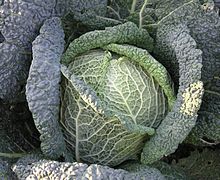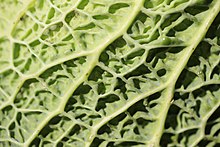savoy
Savoy cabbage ( Brassica oleracea convar. Capitata var. Sabauda L. ) (via Lombard verza of Latin viridia "green plants"), including kale , Welsch carbon , Welsch cabbage , Savoy (coal) , Savoyerkohl , Bavarian Wirsching , in the Rhineland Schavur , Swiss German Wirz or Köhli and simply called cabbage in Austria , is a head cabbage and a cultivated variety of vegetable cabbage . It is characterized by curled leaves.
description
features
When savoy cabbage has reached the critical 4-leaf stage 4–8 weeks after sowing, temperatures between 0 and 12 ° C trigger the transition to flower formation . Slow-growing varieties are more sensitive to flower growth (" shoots "). If at this stage the plant experiences a lot of incidence of light and temperatures of 20 to 25 ° C, flower development can be interrupted - the plant only develops leaves again. The growth is similar to that of white and red cabbage, but has wavy leaves that are loosely arranged, yellow to dark green and develop into a round to pointed head after rosettes have formed. The leaf curl is caused by faster growth of the parenchyma , while the leaf veins lag behind in growth. The corrugation also causes the head to be stratified much more loosely than white and red cabbage. Flat-round varieties are also known. As with other types of headed cabbage, the head of the plant corresponds to a strongly compressed end bud, whereby the stalk formed inside is stronger than in white and red cabbage. Due to the special leaf growth, the leaf margins (leaf edges) are also wavy. The plant grows on a more or less long stalk and lies on the ground, especially in larger stages. Later varieties are a little darker in color and usually have a clearly visible layer of wax that can be wiped off with your fingers. Savoy cabbage grows a little faster than other types of head cabbage.
Origin and history
Cabbage has been known since the 8th century. The distinction between white and red cabbage has been made since the 11th century. The wavy savoy cabbage was first mentioned in the 16th century. Savoy cabbage comes from the Mediterranean region , probably from northern Italy, hence the French name chou de Milan (cabbage from Milan ) and other names for savoy cabbage that refer to the Savoy region , e.g. As Savoy cabbage , Dutch: Savooiekool , English: Savoy cabbage , Norwegian: savoykål : Savoy was the name for the northern Italy, which at that time by the House of Savoy was dominated. Savoy cabbage has been grown in Germany since the 18th century and is now common in all parts of the world.
meaning
Savoy cabbage is available all year round, first as a milder early sausage, later as an autumn or permanent sausage. There are significant areas under cultivation in Germany, the Netherlands, Belgium and France. In Denmark, on the other hand, savoy cabbage is grown only to a very limited extent. The annual harvest in Germany is around 50,000 tons. The head weight (harvest weight) was considered ideal up to a few years ago at 1 to 2 kg. In the meantime, weights of 400–600 g per head are more in demand for fresh marketing. Larger head weights are only preferred for industrial recycling.
use
Cultivation and harvest
In order to increase the yield of savoy cabbage, CMS varieties (F1 hybrids) are mostly grown today . According to the cultivation, the different varieties are divided into types for early, medium and late cultivation. This classification is also referred to as spring, summer, autumn and winterwirsing. The late cultivation is used for storage in winter. Savoy cabbage is not quite as demanding as other types of head cabbage. Depending on the variety and the intended size, 13–26 weeks are required for early varieties and 26–40 weeks for late varieties. The yield for early varieties is 25 to 30 tons and for late varieties 35 to 40 tons per hectare. The head size and shape can be influenced depending on the distance. Since savoy cabbage grows faster than white and red cabbage, it is ready to be cut earlier.
Pests and diseases
The diseases and pests correspond to those of white and red cabbage . For example, the cabbage white butterfly or its caterpillars are possible pests.
use
kitchen
Savoy cabbage can be used even if it is not yet firmly in place. It is very versatile in the kitchen because its leaves are more tender than most other types of cabbage. In addition, it has a crisper leaf and is more decorative in salad mixes because of its wavy shape. The inner, light leaves are cooked after a short time and can be used as a vegetable side dish. Other preparations are filled savoy cabbage or stews . The larger leaves are particularly suitable for cabbage rolls . The one- pot dish Pot-au-feu , which is served with boiled meat, is also well known in Switzerland . Savoy cabbage is also occasionally part of the soup greens .
ingredients
Savoy cabbage has 130 kilojoules (31 kilocalories) per 100 g and, like all types of cabbage, contains plenty of mustard oil glycosides , a particularly large amount of chlorophyll , twice as much protein, fats, also iron and phosphorus as white and red cabbage, furthermore carotenes , several B vitamins . Raw it covers the daily requirement of vitamin C with 100 g .
storage
The heads of savoy cabbage do not last as long as white or red cabbage. Late varieties, which are more resistant to frost, can remain in the field and overwinter. When compared to other types of headed cabbage, savoy cabbage is the most resistant to frost.
Individual evidence
- ^ Mansfeld's World Database of Agriculture and Horticultural Crops online query. IPK Gatersleben, accessed on February 11, 2010 (English).
- ^ Commission of the association "Arbeiterwohl" (Ed.): The domestic happiness . Complete housekeeping lessons and cooking instructions for working women. 11th edition. A. Riffarth, 1882, p. 60 .
- ↑ Menu-Kochredaktion (Ed.): Menu . The great modern cooking dictionary. tape 10 , p. 221 (licensed edition for Bertelsmann Reinhard Mohn OHG, Gütersloh, etc.; Book No. 05819 8).
- ↑ Bavarian dictionary.
- ↑ a b Johannes J. Arens: ethnographic notes 005a: wirsing. In: Nachschlag - Food culture in words and pictures. Retrieved November 27, 2019 .
- ↑ https://www.lid.ch/medien/mediendienst/detail/info/artikel/wirz-der-gekrauste-kohl/
- ↑ a b c H.L. Vilmorin: choux de milan , In: Les Plantes Potagères; Descroption et culture des Proncipaux Légumes des climats tempéré. , Troisième Édition, 1904, pp. 135-143.
- ↑ J. Schlaghecken et al .: Cultivation and variety information for vegetable growing 1999/2000 , Neustadter Hefte, No. 5, 9th expanded edition, 1998, pp. 110–111.
- ↑ a b c d F. Keller, J. Lüthi, K. Röthlisberger: Wirz , in: 100 Vegetables , First Edition, 1986, pp. 54-57.
- ↑ a b J. Becker-Dillingen: Handbook of the entire vegetable cultivation , 1950, pp. 308-315.
- ↑ a b c J. Böttner: Garden book for beginners - the advisor in creating, planting and caring for the garden, in fruit growing, vegetable growing and in floriculture , 22nd edition, Gartenbauverlag Trowitzsch & Sohn, Frankfurt / Oder and Berlin, 1940, p. 275 .
- ↑ a b c d e M. Blangstrup Jørgensen et al .: Grøntsager på friland , GartnerINFO, København, 2nd edition, reprint, 1987, pp. 262-263, ISBN 8-7880-7754-3 .
- ↑ Roger Müller: Swiss vegetables from genetic laboratories: the consumer has no choice. In: srf.ch . September 2, 2014, accessed March 17, 2019 .
- ↑ a b K. Reichelt and N. Nicolaisen: Die Praxis des Gemüsebaues - instruction and manual for the practical grower and for use in educational establishments , Paul Parey publishing house, Berlin, 1931, pp. 130-131.
- ↑ caterpillars of the cabbage white butterfly - Gartenratgeber.net. Retrieved January 19, 2017 .
- ^ Ingeborg Münzing-Ruef: Course book healthy nutrition: The kitchen as a pharmacy of nature . Heyne, 2000, ISBN 978-3-453-12256-7 .
- ↑ L. Müller et al .: Vegetable growing - A handbook and textbook for horticultural practice , approx. 1937, p. 439.


